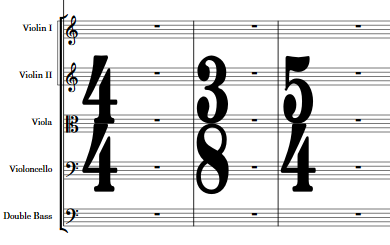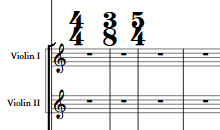Large time signatures
Large time signatures are scaled-up time signatures that appear much larger than normal relative to the staff size. They can be helpful in orchestral scores, as the smaller staff size in such scores means standard time signatures are small and harder for conductors to read.
Large time signatures are also very commonly used in film scores, as conductors rarely have much time to prepare the scores before recording sessions. Having large time signatures makes changes in meter more visually clear on the page, especially when music contains multiple changes in meter.
In Dorico Pro, you can show large time signatures at the following positions:
-
Once per bracketed group
-
Above the staff and at system object positions
Time signatures shown once per bracketed group
Instead of showing a time signature on every staff that is the same height as the staff, you can instead show a single large time signature on each bracketed group of staves. When shown once per bracketed group, time signatures are scaled up in size according to the number of staves in the bracketed group. The largest time signatures are shown on bracketed groups containing four or more staves. When shown on single staves, they extend a small amount above and below the staff, which is commonly used for parts for film music recording sessions.

You can change the size of time signatures on different sizes of bracketed groups on the Time Signatures page in . You can also change whether all the staves between the brass and string brackets, which often include percussion, harp, and piano, are treated as a single bracket or separately for the purposes of showing large time signatures.
Large time signatures shown on bracketed groups occupy horizontal space, which can be a significant amount when they are especially large and use the standard time signature design. Therefore, we recommend that you use one of the narrow designs in layouts that show large time signatures on bracketed groups.
Time signatures shown at system object positions
Similar to showing large time signatures once per bracketed group, you can also show time signatures only at system object positions and above the staff. Therefore, its positions in each system are controlled by the same options that control the positions of other system objects, such as rehearsal marks and tempo marks.

Time signatures shown at system object positions do not occupy horizontal space, meaning it is less important to use a narrow font style. This also reduces the horizontal distance between notes either side of time signatures. Because of this reduced disruption to note spacing, this placement of time signatures has become popular in contemporary art music since the 20th Century.
When using the note denominator style for time signatures shown at system object positions, the note is shown to the right of the numerator rather than below.
By default, time signatures at system object positions are twice the size of normal time signatures and force other items at the same position to appear to the right. You can change their scale factor and the default position of other items at the same position on the Time Signatures page in Engraving Options. You can also change their alignment relative to barlines.